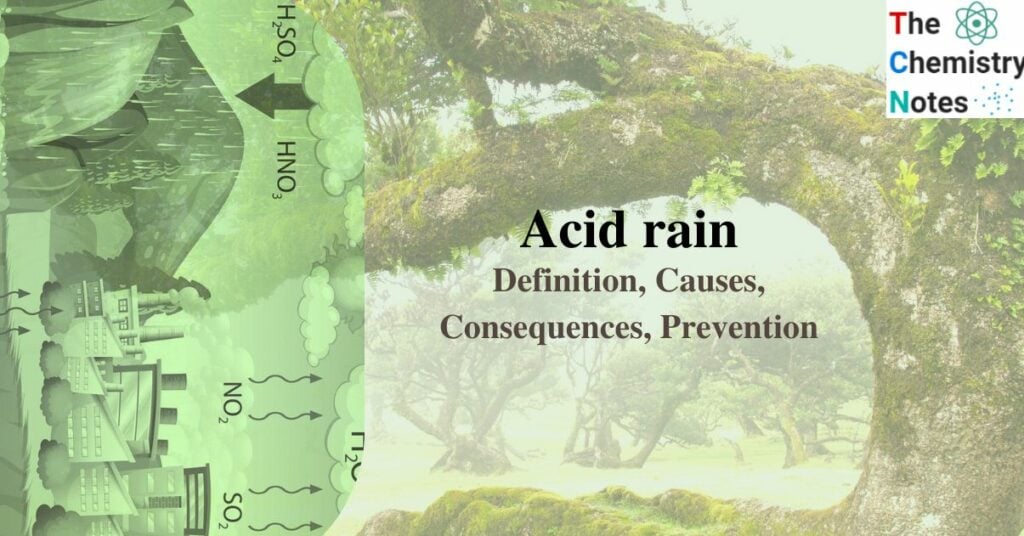
Acid rain is the most serious environmental concern caused by air pollution. Lakes, streams, plants, and animals that inhabit these ecosystems suffer severe danger from acid rain. Rain that has a pH value of less than 5.6 and a concentration of H+ ions larger than 2.5 eq-1 is regarded as acidic.
Causes of acid rain
Natural sources
Normal rainwater is slightly acidic due to the absorption of carbon dioxide (CO2) from the atmosphere, which generates carbonic acid, and organic acids produced by biological activity.
Acid rain is primarily caused by sulfur dioxide (SO2), nitrogen oxides, and ozone. These compounds react with reactants in the atmosphere, resulting in acid deposition. The formation of nitrogen oxides from the conversion of air molecular nitrogen (N2) by lightning, as well as the conversion of organic nitrogen by wildfires, are natural sources of acidification. In addition, depending on the emissions linked to certain volcanoes, volcanic activity can result in the production of hydrochloric acid (HCl), nitric acid, and sulfuric acid (H2SO4). However, the geographic area of any particular natural source of acidification is limited, and in most situations, it only lowers the pH of precipitation to about 5.2.
Anthropogenic activity
Acid deposition is mostly caused by anthropogenic activity, especially the burning of fossil fuels (coal, oil, and natural gas) and the smelting of metal ores. Nearly 70% of SO2 and about 20% of NOx emissions are also produced by electric utilities. Other sources include the production of sulphuric acids, the smelting of iron and other metallic (Zn and Cu) ores, and the use of acid concentrators in the petroleum sector.
Chemical reactions involved during acid rain formation
The interaction of SO2, NOx, and O3 causes the chemical reaction that produces acid rain. Molecules of SO2 and NOx that are released into the sky by high smokestacks are caught in the existing winds, where they combine with vapors in the presence of sunlight to generate sulphuric acid and nitric acid mists. When the temperature drops, condensation forms in the form of aerosol droplets.
Reactions involving nitrogen:-
NO + O3 → NO2 + O2
NO2 + O3→ NO3 + O2
NO2 + NO3 → N2O5
N2O5+ H2O → 2HNO3
Nitric Acid
Reactions involving sulfur:
Coal contains a high concentration of sulfur. As coal burns, its constituents oxidize to SO2 as follows:
S + O2 → SO2
Direct sulfur oxidation to SO2 takes place by flame. As a result, the smoke stacks release SO2 into the environment. As SO2 is carried along by the wind, it progressively oxidizes to SO32- at ordinary temperature.
2 SO2 + O2 →2 SO32-
SO3 2-+ H2O →H2SO4
Effects of Acid Rain
- The marble and limestone used in construction and sculpture suffer significant damage from acid rain. As rainwater leaches the soluble sulfates out of these materials, they get pitted and break down mechanically.
CaCO3 + H2SO4 → CaSO4 + CO2 + H2O
- Acid rain can damage leaves, severely injure cells, and have other effects on plants. The fertility of the soil declines as the acidity of the soil rises.
- It weakens trees and makes them more vulnerable to damage from other stressors including drought, extremely cold weather, and pests.
- In acid-sensitive places, acid rain also depletes the soil of crucial plant nutrients and buffers, such as calcium and magnesium, and can liberate aluminum bound to soil particles and rock, releasing it in its hazardous dissolved form.
- The aquatic ecology is impacted by acid rain when it rains down and enters ponds, rivers, and lakes. It results in water pollution and changes the composition of the water in a way that makes it difficult for aquatic ecosystems to exist.
- It causes skin diseases.
- Acid rain also corrodes water pipelines, resulting in heavy metals such as iron, lead, and copper leaking into drinking water.
- It can also lower methane, which means it can help to mitigate global warming.
- It makes pores in the limestone beneath the ground, resulting in groundwater storage and species habitats.
Prevention of acid rain
The only approach to lessen the effects of acid rain is to minimize the emission of nitrogen and sulfur oxides, which can be done by:
- Lowering reliance on non-renewable energy sources including coal, oil, and natural gas.
- utilizing eco-friendly automobiles in place of those driven by gasoline or diesel.
- By filtering the exhaust before releasing it into the environment, the coal-based and metal extraction sectors may control their emissions.
- Afforestation reduces hazardous gas emissions, which helps to filter the air.
References
- https://www.epa.gov/acidrain/what-acid-rain
- https://byjus.com/chemistry/acid-rain/
- https://www.britannica.com/science/acid-rain/Effects-on-lakes-and-rivers
- https://www.climateandweather.net/world-weather/acid-rain/
- https://www.sciencefacts.net/acid-rain.html
